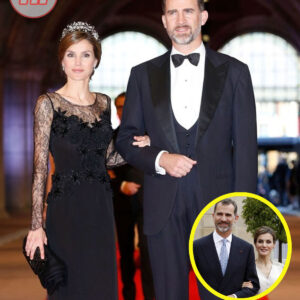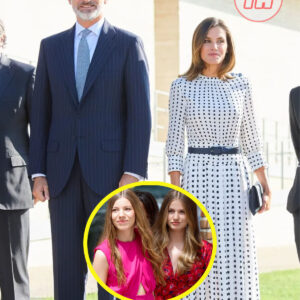Inside the Lives of the Spanish Royal Children: A Closer Look
The lives of royal families around the world have always been a subject of fascination and intrigue for the public. In Spain, the Spanish Royal Children—Princess Leonor and Infanta Sofía—have grown up under the spotlight, balancing the expectations of royalty with the normalcy of childhood. This article delves into their upbringing, education, roles within the royal family, and the challenges and privileges that come with being born into royalty.
Early Years and Family Dynamics
Princess Leonor, born on October 31, 2005, and Infanta Sofía, born on April 29, 2007, are the daughters of King Felipe VI and Queen Letizia. Their upbringing has been carefully orchestrated to blend tradition with modernity, reflecting the evolving role of the Spanish monarchy in the 21st century. From an early age, they were introduced to their responsibilities as future representatives of Spain, attending public events and ceremonies alongside their parents.
The family dynamic is crucial in shaping the lives of the royal children. King Felipe and Queen Letizia have been noted for their efforts to provide a balanced upbringing, shielding their daughters from excessive media attention while ensuring they understand the significance of their royal lineage. The princesses have been described as well-mannered and grounded, traits that are encouraged within the royal household.

Education and Academic Pursuits
Education plays a pivotal role in the lives of Princess Leonor and Infanta Sofía. Like their parents, who are both highly educated individuals—King Felipe holds a law degree and Queen Letizia was a journalist—they have been enrolled in prestigious educational institutions that emphasize academic excellence and personal development.
Princess Leonor, as the heir to the Spanish throne, attends the Santa María de los Rosales School in Madrid, where she is known for her dedication to her studies and her fluency in multiple languages. Infanta Sofía also attends the same school, following in her sister’s footsteps with a strong focus on academics and extracurricular activities.
Their education is complemented by lessons in Spanish history, culture, and diplomacy, preparing them for their future roles as ambassadors of Spain. The royal children are expected to be well-versed in matters of state and to embody the values that uphold the monarchy’s legacy.

Roles within the Royal Family
Despite their young age, Princess Leonor and Infanta Sofía have gradually assumed more prominent roles within the Spanish royal family. They often accompany their parents on official visits and engagements, where they greet dignitaries and participate in ceremonial events. These appearances not only showcase their public demeanor but also reinforce their connection to the Spanish people.
As they grow older, their roles are likely to expand, with opportunities to engage more directly in charitable work and initiatives that align with their personal interests. The royal children are encouraged to develop their own identities while honoring their heritage, striking a balance between tradition and modernity that defines their upbringing.
Challenges and Privileges of Royal Life
Living as members of a royal family comes with unique challenges and privileges. While Princess Leonor and Infanta Sofía enjoy access to resources and opportunities that many children may not experience, they also face the scrutiny of public opinion and the weight of familial expectations. Their actions and choices are scrutinized by both the Spanish media and international observers, necessitating a cautious approach to their public and private lives.
Moreover, the royal children must navigate the complexities of balancing their roles as public figures with their personal aspirations. Their upbringing is carefully managed to safeguard their privacy and emotional well-being, ensuring they have a childhood that is as normal and fulfilling as possible within the constraints of royal protocol.

Future Outlook and Continuity
Looking ahead, the future of Princess Leonor and Infanta Sofía as integral figures within the Spanish monarchy is a topic of considerable interest. As they mature, they will undergo further preparation for their eventual roles as leaders and representatives of Spain. This preparation includes exposure to diverse perspectives, training in diplomacy, and cultivating relationships with global leaders.
The continuity of the Spanish monarchy relies on the readiness of the next generation to uphold its traditions and adapt to the evolving demands of contemporary society. Princess Leonor and Infanta Sofía are poised to play pivotal roles in shaping the monarchy’s future, embracing both its storied past and its potential for modernization.
In conclusion, the lives of the Spanish Royal Children—Princess Leonor and Infanta Sofía—are shaped by a unique blend of tradition, education, and public service. Their upbringing underlines the delicate balance between maintaining royal protocol and embracing the freedoms of childhood.
As they continue to grow and develop, they will navigate the challenges and opportunities that come with their royal status, ultimately preparing to carry forward the legacy of the Spanish monarchy with grace and purpose. Their journey is not only a testament to their individual resilience but also a reflection of the enduring relevance of royalty in a changing world.
News
El coste de la monarquía española: Los reyes Letizia ganan una enorme cantidad de dinero cada año
La Zarzuela aplicó una subida del 3% respecto al presupuesto del 2022, tanto a las retribuciones de los Reyes como las del resto de funcionarios. El costo de la monarquía española: el Rey cobró más 250.000 euros y la reina…
La infanta Sofía y Leonor desencadenan un problema de celos que parte a Zarzuela en dos
No todos ven bien en Zarzuela que Leonor y Sofía hayan adquirido un fuerte protagonismo En los últimos meses, la familia real española ha sido escenario de un conflicto que ha sacudido las bases de Zarzuela. La revelación explosiva hecha por Jaime del Burgo ha intensificado la…
En qué se gasta el dinero la Familia Real: 4,1 millones en personal, 550.000 en teléfono y 60.000 en libros y prensa
Uno de los temas que más polémica genera en la política española es la cuestión monárquica. No solo por los escándalos asociados a la institución, sino también por el dinero que reciben anualmente. Como dispone el artículo 65.1 de la Constitución,…
CONOCE AL CADETE QUE CASI BESA A LA PRINCESA LEONOR
Conoce al Cadete que Casi Besa a la Princesa Leonor: Un Incidente que Conmocionó a España Recientemente, España ha sido testigo de un incidente que ha capturado la atención de medios y público por igual: un cadete de la Academia…
La princesa Leonor se une a Sofía para la foto ‘Pero por orden de la reina Letizia’
La Princesa Leonor se Une a Sofía para la Foto: “Pero por Orden de la Reina Letizia” La fotografía de la Princesa Leonor y la Infanta Sofía, capturada recientemente en un evento oficial, ha generado una avalancha de especulaciones y…
El ultra lujoso estilo de vida de la Princesa Leonor de España
El Ultra Lujoso Estilo de Vida de la Princesa Leonor de España: Un Vistazo a la Vida de la Heredera La Princesa Leonor de Asturias, hija mayor del Rey Felipe VI y la Reina Letizia, no solo es la heredera…
End of content
No more pages to load











